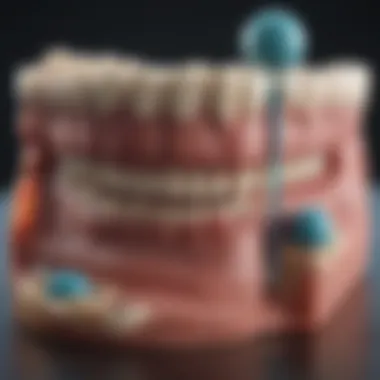ADA Caries Risk Assessment: An In-Depth Overview


Intro
Caries, commonly known as tooth decay, presents a persistent challenge in the field of dentistry. Its impact reaches beyond mere oral health, affecting physical well-being and overall quality of life. Addressing caries effectively requires a keen understanding of individual risk factors. The American Dental Association (ADA) has developed the Caries Risk Assessment framework to evaluate these risks comprehensively. This guide showcases a systematic approach to predicting caries development in individuals, assisting dental professionals in implementing tailored prevention strategies.
In exploring the ADA Caries Risk Assessment, we will focus on several crucial aspects. We will highlight key points concerning its methodologies, the significance of tailored prevention approaches, and how risk factors integrate into clinical practice. Furthermore, we will examine the implications of accurate assessments on clinical outcomes and patient welfare, providing a well-rounded view of the relevance of this topic in contemporary dentistry.
Understanding Caries and Its Implications
The examination of dental caries is critical in dentistry, as it directly impacts individual and community health. Understanding the implications of caries leads to better preventive strategies, which can improve overall oral health outcomes. This section explores the fundamental aspects surrounding dental caries, its prevalence, and the consequences of neglect. This comprehensive understanding is essential in the context of caries risk assessment.
Definition of Dental Caries
Dental caries, commonly known as tooth decay, is a multifactorial disease characterized by the demineralization of tooth structures. It occurs when bacterial processes achieve an imbalance, leading to the accumulation of acids that erode enamel and dentin. The bacteria involved in this process metabolize sugars, creating acidic byproducts. The protective factors, such as saliva and fluoride, play a crucial role in maintaining oral health and combating the detrimental effects of these acids. Understanding this definition provides a foundation for recognizing the complexities surrounding caries and its management in clinical settings.
Statistics on Caries Prevalence
Caries prevalence remains a significant concern worldwide. Current studies indicate that approximately 91% of adults aged 20 to 64 have suffered from dental caries at some point in their lives. Even more concerning, surveys show that around 27% of adults have untreated carious lesions. In children, the statistics are similarly daunting; nearly 20% of children aged 5 to 11 years have untreated tooth decay. These numbers highlight a pressing public health issue, necessitating effective caries risk assessment strategies to address and mitigate these alarming trends.
Consequences of Untreated Caries
The ramifications of untreated caries extend beyond mere oral discomfort; they can lead to severe health issues. Untreated caries can result in pain, infection, and tooth loss, affecting daily activities and quality of life. Moreover, systemic conditions linked to oral health, such as cardiovascular diseases and diabetes, are exacerbated by poor dental hygiene and untreated dental issues. The social and economic costs associated with these consequences are profound, making timely diagnosis and treatment essential for maintaining overall health.
"Neglecting dental caries can result in life-altering consequences, affecting not just the mouth, but the body as a whole."
In summation, understanding the various facets of dental caries, including its definition, prevalence, and consequences, sets an important stage for effective caries risk assessment. By acknowledging these implications, the ADA's Caries Risk Assessment Tool can be better utilized in clinical settings to provide personalized care and preventive strategies.
Historical Context of Caries Risk Assessment
Understanding the history of caries risk assessment provides a foundational insight into how dental professionals approach decay prevention today. The evolution of these assessment tools reflects changes in public health strategies and clinical practices aimed at reducing dental caries, which remains one of the most prevalent chronic diseases across populations.
Evolution of Caries Risk Assessment
Caries risk assessment has its roots in early dental research conducted in the 19th and 20th centuries. Initial studies focused on merely identifying the presence of caries through visual examinations. However, as knowledge expanded, the need for predicting caries susceptibility became apparent. This emerging field recognized that not all patients have the same risk of developing carious lesions. Therefore, diverse factors—including genetics, diet, and oral hygiene practices—were taken into consideration.
By the 1970s, significant advancements were made when the first comprehensive models were proposed. These models allowed clinicians to categorize patients based on identifiable risk factors, laying the groundwork for personalized treatments. The introduction of the first formal caries risk assessment tool, along with subsequent revisions, reflected ongoing research and clinical observations.
Key Milestones in Caries Research
There have been several pivotal points in the evolution of caries risk assessment that underscore its importance:
- Dental Caries as a Public Health Concern: In the early 20th century, the connection between nutrition and dental decay began to be understood, galvanizing public health initiatives.
- Introduction of Preventive Dentistry: The 1960s and 1970s saw the rise of preventive dentistry, highlighting the importance of education and patient engagement in reducing caries risk.
- Scientific Training for Practitioners: The 1990s emphasized the solidification of risk assessment in dental education as dentists began to learn about evidence-based practices.
"Risk assessment in dentistry is not just about counting cavities; it’s about understanding the underlying biological and behavioral factors that contribute to oral health."
With continuous research, assessment tools have been refined to include various methodologies. These methodologies draw upon interdisciplinary studies, incorporating behavioral sciences and public health concepts to create a robust framework for dental practice. Overall, the historical context of caries risk assessment not only illustrates the importance of early intervention but also informs current practices, making it possible for individual treatment plans that cater to each patient's unique needs.
This historical overview underlines how evolving understandings have transformed caries management, thereby enhancing clinical practices and patient outreach.


The ADA Caries Risk Assessment Tool
The ADA Caries Risk Assessment Tool serves as a pivotal mechanism in predicting caries development. Its importance lies in its structured approach to evaluating individual risk factors, thus allowing for selective interventions that can lead to better clinical outcomes. Assessments utilizing this tool reflect a commitment to preventive care, which is critical for enhancing overall oral health. By identifying the specific risk elements unique to each patient, dental practitioners can craft personalized strategies that directly address potential caries development.
Overview of the Tool
The ADA Caries Risk Assessment Tool is designed to collect essential information about a patient’s oral health status. This tool encompasses both biological and behavioral factors to create a comprehensive profile of risk. The tool is particularly effective because it is not limited to past dental history; it also considers lifestyle, dietary habits, and socioeconomic influences. This multi-faceted evaluation leads to an accurate risk stratification, which is vital for ensuring appropriate preventive measures are put in place.
Components of the Assessment
The assessment includes several key components:
- Patient History: Questions regarding previous caries incidence, restorative history, and fluoride exposure.
- Clinical Examination: An evaluation of current oral health, including the presence of plaque, gingival health, and any visible carious lesions.
- Dietary Assessment: Insight into dietary habits, particularly sugar intake, which directly influences caries risk.
- Socioeconomic Factors: Consideration of a patient's access to dental care, education, and income level, which can impact oral health behaviors.
Each of these components plays a significant role in establishing an accurate risk profile. The integration of these elements fosters a deeper understanding of how various factors contribute to caries development, facilitating more tailored preventive measures.
Administration Procedures
Administering the ADA Caries Risk Assessment involves several critical steps to ensure accuracy and effectiveness.
- Preparation: Practitioners should familiarize themselves with the tool and gather necessary patient materials.
- Patient Interaction: A calm environment during consultations encourages open communication. This will allow patients to share their history truthfully.
- Data Collection: Information should be gathered systematically, ensuring all relevant areas are covered.
- Analysis and Interpretation: The results must be evaluated in the context of the whole patient, considering various influences that may have emerged in the assessment.
- Follow-up Planning: Based on the risk level determined, appropriate follow-up appointments and tailored prevention strategies should be established.
Following these procedures will enhance the reliability of the assessment, allowing for optimum usage of the tool in clinical practice. Direct application of the findings into patient care will ultimately improve health outcomes.
Risk Factors in Caries Development
Understanding the risk factors contributing to caries development is crucial in shaping effective prevention strategies. Insight into these factors enables both practitioners and patients to adopt informed approaches to oral health. As dental professionals assess a patient's risk, they can tailor recommendations that target specific vulnerabilities, enhancing treatment outcomes. The identification of risk factors empowers individuals to take proactive measures against caries.
Biological Factors
Biological factors encompass the inherent characteristics of an individual that influence their susceptibility to dental caries. These include attributes such as saliva composition, dental anatomy, and the presence of specific bacteria in the oral cavity. Saliva plays a pivotal role in maintaining oral health by neutralizing acids and providing essential minerals for enamel remineralization.
Some individuals may experience lower saliva flow due to conditions like xerostomia, or dry mouth, increasing their risk for caries. Furthermore, traits like tooth morphology can affect the retention of food particles, making certain individuals more predisposed to decay.
Additionally, the microbial composition of the mouth is significant. The presence of certain bacteria, such as Streptococcus mutans, is linked to the onset of caries. Individuals with a higher concentration of these bacteria may experience more rapid decay development. Overall, identifying these biological factors is essential to customize caries management.
Behavioral Factors
Behavioral factors relate to individual habits and lifestyles that can influence caries risk. Key behaviors include diet, oral hygiene practices, and regular dental visits. A diet high in sugars and acids is one of the primary contributors to caries. Individuals consuming excessive sugary snacks or drinks are at heightened risk for the development of dental caries.
Furthermore, inadequate oral hygiene practices, such as infrequent brushing and flossing, can lead to plaque accumulation, which is a catalyst for decay. Educating patients about the importance of consistent oral care is crucial in mitigating this risk.
Regular visits to a dentist contribute substantially to caries prevention. Professionals can provide valuable insights into individual risk profiles. Early diagnoses lead to timely interventions, ultimately improving overall oral health. By influencing these behavorial factors positively, patients can significantly reduce their likelihood of developing caries.
Socioeconomic Influences
Socioeconomic factors can not be overlooked when discussing caries risk. Individuals from lower socioeconomic backgrounds may face barriers to accessing dental care. This includes financial constraints, lack of insurance, and limited understanding of oral health importance. These factors can lead to delayed treatment and untreated dental issues.
Education plays a critical role in oral health literacy. Individuals with higher levels of education are more likely to understand the importance of oral hygiene practices and preventive measures. Moreover, community resources and support systems can promote better access to dental care, thereby reducing caries risk.


The interplay between socioeconomic status and oral health highlights the need for targeted public health initiatives. Such initiatives aim to improve access to dental care and education for at-risk populations. Expanding outreach can change the landscape of dental health, especially in communities facing significant socioeconomic challenges.
Implementing Risk Assessment in Clinical Practice
Implementing caries risk assessment in clinical practice is a vital step towards effective dental care. This process empowers practitioners to predict potential caries development. By evaluating individual risk factors, dental professionals can tailor their approach to each patient. This personalized care enhances oral health outcomes significantly.
Integrating Assessments into Patient Care
Integrating assessments into patient care requires strategic planning. The first step involves gathering comprehensive dental histories. Information about past caries and current oral hygiene habits can provide insight into future risks. Using tools like the ADA Caries Risk Assessment Tool, practitioners can engage in informed discussions with patients. The result is a shared understanding of the patient's needs.
Moreover, documenting assessments is crucial. This documentation allows for tracking changes over time. Trends in caries development can indicate the effectiveness of preventive measures introduced. It is essential to keep patients informed about their risk status. Regular updates encourage compliance with recommended strategies.
Training and Education for Dental Practitioners
Training and education for dental practitioners are indispensable components of implementing risk assessments. Continuous education ensures that practitioners stay updated on the latest guidelines and tools. Workshops focused on the ADA Caries Risk Assessment Tool can enhance practitioners' skills and confidence.
Practical training sessions help in understanding patient interactions. Role-playing patient scenarios allows for developing communication techniques that convey risk factors effectively. Furthermore, engaging with peer discussions aids in sharing successful practices and new insights.
In summary, the effective implementation of caries risk assessments involves integrating these practices into patient care while ensuring dental practitioners are well-trained. This comprehensive approach aims to elevate the quality of care in dental practices.
Personalized Prevention Strategies
Personalized prevention strategies play a significant role in the ADA Caries Risk Assessment framework. These strategies focus on tailoring dental care and preventive measures to fit each individual’s unique risk profile. The significance of personalizing approaches cannot be overstated, as it ensures more effective prevention and management of dental caries.
This paradigm shift from generalized preventive measures to individualized care takes into account various factors such as genetics, lifestyle choices, and existing oral hygiene habits. It is important to recognize that not all patients respond similarly to preventive strategies; hence, a one-size-fits-all method may not suffice.
Tailored Treatment Plans
Tailored treatment plans are essential in managing caries risk effectively. By assessing each patient’s specific risk factors, dental practitioners can develop customized plans that address their unique needs.
For instance, a patient with high caries risk stemming from frequent sugary snacks may benefit from more frequent dental checkups and fluoride treatments. On the other hand, someone with a good oral care routine but a history of caries may require education on maintaining their current habits.
The following factors should be considered when developing tailored treatment plans:
- Risk Level: Identifying high, moderate, or low risk based on several clinical assessments.
- Health History: Understanding medical and dental history for informed decision-making.
- Patient Preferences: Incorporating feedback from patients about their priorities and concerns regarding treatment.
Personalized care can immensely improve patient outcomes by increasing compliance and satisfaction levels.
Patient Education and Engagement
Patient education is a cornerstone of effective caries prevention. Engaging patients in their care empowers them to take charge of their oral health. Through education, patients become aware of their specific risk factors and understand the rationale behind their tailored treatment plans.
Effective strategies for education and engagement include:
- Counseling Sessions: Discussing diet modifications, oral hygiene techniques, and the importance of regular dental visits.
- Visual Aids: Utilizing charts or models to demonstrate effective brushing and flossing techniques.
- Follow-Up Communication: Regular reminders through emails or text messages to encourage adherence to recommended practices.
Involving patients in their care not only fosters a sense of responsibility but also enhances the effectiveness of the prevention strategies. Engaged patients are often more likely to maintain their oral hygiene practices, which can result in better long-term outcomes.
Evaluating the Effectiveness of Risk Assessments


Evaluating the effectiveness of caries risk assessments is crucial for improving patient care in dentistry. It is essential to determine how well these assessments predict caries development and how they influence treatment outcomes. When risk assessments are effectively implemented, they can lead to tailored preventive strategies, resulting in better oral health for patients.
Assessing the effectiveness involves the use of specific metrics. These metrics include the accuracy of predictions made by the assessments and how closely outcomes align with these predictions. Higher accuracy means healthcare providers can better identify patients at high risk of developing caries and offering timely interventions.
Moreover, the benefits of evaluating risk assessments extend to creating more efficient practices within dental clinics. By confirming which assessment methods yield the best results, practitioners can refine their approach, making them more effective in addressing patient needs. Therefore, this evaluation is not merely a numerical exercise; it is an integral part of clinical decision-making that ultimately enhances patient outcomes.
"Effective evaluation of caries risk assessments leads to improved preventive strategy formulations and better oral health management."
Measuring Outcomes and Success Rates
Measuring outcomes and success rates is a critical aspect of evaluating risk assessments in caries prevention. These measures provide evidence-based insights into whether the strategies employed are working. It includes tracking incidents of caries development before and after implementing personalized prevention plans based on the assessment results.
Factors taken into account for measuring successful outcomes include:
- Reduction in Caries Incidence: This is the primary indicator of effectiveness. A lower incidence rate among patients who underwent caries risk assessment-based interventions compared to those who did not is a clear sign of success.
- Patient Feedback: Engaging patients in the evaluation process helps gather subjective data on their perceptions about oral health improvements and overall satisfaction with care.
- Clinical Record Analysis: Monitoring changes in clinical findings over time provides hard data to measure the effectiveness of the assessment tool.
The successful implementation of these assessments can lead to significant improvements in patient health outcomes. By establishing clear metrics for success, dental professionals can enhance their practice and ensure better dental health for their patients.
Feedback Mechanisms for Improvement
Feedback mechanisms are essential for the continuous improvement of caries risk assessments. Gathering feedback from both practitioners and patients aids in refining risk assessment tools, ensuring they remain relevant and effective over time. This iterative approach helps identify areas for enhancement, addressing limitations observed during real-world applications.
Key components of effective feedback mechanisms include:
- Regular Surveys and Questionnaires: Conducting surveys with both patients and providers can help gather insights on their experiences with the risk assessment process. This feedback is vital for identifying issues and successful elements.
- Clinical Audits: Periodically revisiting clinical practices involving caries risk assessments helps review their relevance and effectiveness. Audits can reveal trends in caries occurrences and how well assessment methods respond to those trends.
- Engagement in Professional Networks: Sharing experiences and outcomes with peers in dental communities fosters collaborative learning and continuous adaptation of best practices.
Incorporating feedback into the caries risk assessment process leads to improvements in treatment strategies and enhances overall patient care. This active engagement between dental professionals and patients promotes a culture of continuous learning in the field of dentistry.
Future Perspectives on Caries Risk Assessment
In the realm of dental health, anticipating caries development is paramount. The future of caries risk assessment holds considerable significance, driven by advancing technologies and evolving methodologies. Increasingly, these advancements promise not only to refine diagnostic approaches but also to enhance patient outcomes. As dental practitioners integrate innovative tools into their practices, the comprehensive management of oral health will likely shift towards a more proactive model. This shift underscores the need for adaptive strategies that focus not just on treatment, but also on the prevention of caries formation based on individualized risk profiles.
Emerging Technologies in Caries Risk Evaluation
Emerging technologies are reshaping the landscape of caries risk evaluation. One significant development is the introduction of salivary diagnostics. By analyzing saliva samples, practitioners can gain insights into an individual’s microbial profiles and their susceptibility to caries. The use of digital imaging technologies, including spectral imaging and fluorescence detection, offers enhanced visualization of carious lesions. These methods reduce the dependence on traditional radiography while providing timely and accurate assessments.
Additionally, the integration of artificial intelligence is notable. AI systems can analyze vast amounts of data gathered from patient histories and clinical findings. This capability can enable more precise predictions about future caries risk, ultimately informing personalized care plans. The utilization of mobile health applications also holds promise. These apps can engage patients directly, allowing them to monitor their oral health in real-time and adhere to preventive measures more effectively.
Potential for Broader Applications
The potential applications of refined caries risk assessment tools extend beyond individual patient care. In community health settings, aggregated data from assessments can inform public health initiatives. Understanding caries trends within populations may aid in tailoring educational programs aimed at promoting better oral hygiene practices. Moreover, this data can also help allocate resources more efficiently where they are needed the most.
Further, the relevance of caries risk assessments may reach interdisciplinary frameworks. For instance, integrating dental health assessments with general health programs can foster comprehensive care that acknowledges the interconnectedness of oral health and overall well-being.
Additionally, insurance companies and policymakers can leverage these assessments to devise coverage plans that promote preventive dental care. By prioritizing prevention, the healthcare landscape can evolve towards reducing long-term costs associated with untreated dental caries.
"The move toward a preventative and predictive model in dental care lays groundwork for enhancing public health outcomes."
Closure
The integration of caries risk assessment into clinical practice promotes proactive measures rather than reactive treatments. This shift is essential because it emphasizes the prevention of caries development before it becomes a larger issue. Furthermore, patients informed about their risk levels tend to engage more constructively in their oral health management. This engagement has been shown to lead to better outcomes not only for individuals but also for communities at large.
Additionally, the ongoing evolution of caries risk assessment, including emerging technologies, holds promise for expanding its applicability. These advancements facilitate a deeper understanding of the underlying mechanisms of caries formation, allowing for even more effective interventions in the future. The ties between caries risk assessments and broader health considerations further amplify its relevance in today’s medical landscape.
The journey towards optimal oral health is complex, yet with the ADA’s structured approaches, dental professionals can better navigate this landscape. They can ensure that patients do not just receive treatment after issues arise but also benefit from preventive care tailored specifically for them. Ultimately, adequate caries risk assessment is crucial for advancing public health objectives and improving individual patient health outcomes.







